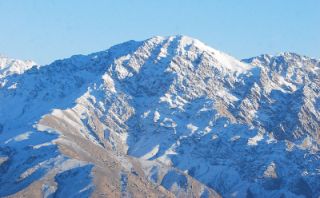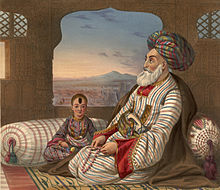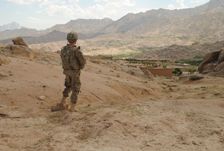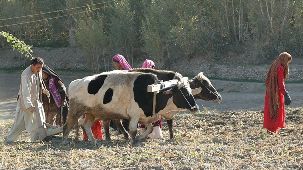History >> Geography >> Asia >>
Afghanistan
Afghanistan
Timeline and History Overview
Afghanistan Timeline
BCE
- 1500 - The Vedec civilization first settles in the area.

- 700 - The Medes conquer the region.
- 330 - Alexander the Great conquers Afghanistan on his way to India. He founded the city of Kandahar which was initially named Alexandria.
- 150 - The Maurya Empire from India conquers much of Afghanistan.
CE
- 642 - The Arabs conquer Afghanistan and introduce Islam. The eastern portion of the region remains a number of independent tribes.
- 998 - Mahmud of Ghazni rises to power. He expands the Ghaznavid Empire to include all of Afghanistan and much of the surrounding region.
- 1040 - The Ghaznavids are defeated by the Seljuq Turks at the Battle of Dandanaqan.
- 1148 - The Ghaznavid Dynasty is defeated by the Ghurids.
- 1219 - Genghis Khan leads the Mongols in an invasion of Afghanistan. Many cities are sacked and destroyed.
- 1370 - Afghanistan becomes part of Tamerlane's Mongol Empire. Herat becomes a major city in the empire. Tamerlane rebuilds much of what Genghis Khan destroyed.
- 1504 - Babur conquers Kabul. He will later form the Mughal Empire which will control the land from Afghanistan to southern India.
- 1738 - Nader Shah leads the Afsharids to victory at Kandahar.
- 1747 - Ahmad Shah Durrani establishes the Durrani Empire. This is considered the founding of the modern state of Afghanistan. Ahmad Shah Durrani is often called the "Founding Father Afghanistan."

Dost Mohammad Khan
- 1776 - The capital city is moved from Kandahar to Kabul.
- 1809 - A treaty is signed with the United Kingdom.
- 1826 - Dost Mohammad Khan declares himself Emir of Afghanistan.
- 1839 - War breaks out between Afghanistan and the British East India Company.
- 1842 - The British are forced to withdraw when their army of 16,000 is completely destroyed.
- 1879 - After another war with Britain, the British retake control of much of the country.
- 1893 - The border between Afghanistan and Pakistan is agreed to as the Durand Line.
- 1919 - Afghanistan declares itself an independent nation from Great Britain.
- 1933 - Mohammed Zahir Shah proclaims himself king.
- 1953 - Prime Minister Daud introduces reforms including some rights for women.
- 1963 - Daud is forced to resign.
- 1964 - A constitution and legislature is introduced.
- 1973 - Daud leads a coup and reclaims power. He declares a republic overthrowing the monarchy.
- 1978 - The Soviet-backed communists assassinate Daud and a civil war begins. Hafizullah Amin becomes president.
- 1979 - The Soviet Union invades Afghanistan in support of the communist government. They have President Amin killed.
- 1980 - The Soviet Union begins fighting a war against Afghan rebels called the Mujahideen.
- 1988 - A peace treaty is signed with the Soviet Union.
- 1989 - The last of the Soviet Union troops leave the country. Civil war breaks out in Afghanistan between the communist government and the Mujahideen.
- 1992 - The communist government falls, but civil war continues as various factions of the Mujahideen struggle for power.
- 1996 - An Islamic fundamentalist group called the Taliban takes control of Kabul. They introduce laws which ban women from work or walking around unescorted by a man. Violators are stoned to death.
- 1996 - The Northern Alliance is formed in opposition to the Taliban.
- 2001 - Around 3,000 people are killed in the 9-11 terrorist attacks in the United States. The attacks are led by the Islamic terrorist group al-Qaeda which is headquartered in Afghanistan. President George Bush demands that the Taliban turn over the al-Qaeda leader and shut down the terrorist camps. When the Taliban refuse, the United States and the United Nations begin bombing Afghanistan.

U.S. Soldier
- 2004 - Hamid Karzai is elected president.
- 2010 - United States President Barack Obama sends additional troops to Afghanistan.
- 2011 - Osama bin Laden, leader of the terrorist group al-Qaeda, is captured and killed.
- 2012 - There are 2.6 million Afghan refugees displaced by war. Many live in horrific conditions including young children and women.
Brief Overview of the History of Afghanistan
The area that is today Afghanistan is sometimes called the crossroads of central Asia. It is surrounded by large and powerful nations such as India, Pakistan, and Russia. The land has changed hands over the centuries as new empires have risen up and taken control.
Prior to Alexander the Great entering the area in 328 BC, Afghanistan was under the rule of the Persian Empire. Over the next thousand years, various invaders took over the country while passing through on their way to other areas. These included the Huns, the Turks, the Arabs, and finally the Mongol invasion by Genghis Khan in 1219.

Farmers
In 1979 the Soviet Union invaded Afghanistan. They backed the Karmal Regime. The country was a difficult place to have a war, however, and the rebels were persistent. They harassed and fought the Soviet troops over the next several years, making it tough for the country to have peace. The Soviet Union finally had enough of the fighting in 1989 and withdrew.
When the Soviet Union withdrew there wasn't anybody in charge. The country went into anarchy and became led by various warlords. In the mid-90's the Taliban came into power. They were in power until 2001, when the United States, together with the United Nations, decided to take out the Taliban for training and harboring terrorists. This war is still ongoing as of 2014.
More Timelines for World Countries:
History >> Geography >> Asia >>
Afghanistan



